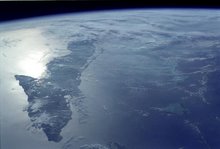
Speaking of Guan- tanamo, there’s the issue of the U.S. naval base there, one of the peculiarities of U.S.-Cuba relations.
U.S. rights to the base were secured in a 1903 agreement signed by Presidents Roosevelt and Estrada Palma. The base consists of two land masses, one on each side of the entrance to the bay (map here).
The base has a website with lots of historical information; it notes that it is “the oldest overseas U.S. Naval Station and the only one in a country with which the U.S. does not maintain diplomatic relations.”
One could add that it’s the only military base we maintain in a country where we don’t care what the host country thinks about our activities there. Well, not quite – the U.S. base commander and the local Cuban military commander have long met monthly at the gate, and both sides say these exchanges are good to maintain.
But Guantanamo is known today for the non-Navy activities that take place on the base by virtue of the fact that it’s something of a no-man’s-land with respect to U.S. law. During the Clinton Administration, when thousands of Haitians took to sea attempting to reach the United States, the Coast Guard and Navy brought intercepted migrants there to care for them until they could be repatriated or, in some cases, to evaluate their claims to refugee status. It served the same purpose for Cuban rafters when thousands of them took to sea in 1994. And today, it hosts the “Detainee Mission of the War on Terrorism following the September 11, 2001, terrorist attacks,” in the words of the base website.
The 1903 agreement provides that Cuba leases the base to the United States “for coaling and naval stations,” and that the United States is permitted “to do any and all things necessary to fit the premises for use as coaling or naval stations only, and for no other purpose.” Cuban officials have not been sticklers about that point. When Washington established the prison for detainees from Afghanistan, they offered support. Today, they enjoy and occasionally join the international argument about U.S. treatment of detainees there.
[U.S. Navy illustration of 1910 exercise at Guantanamo]








1 comment:
The Guantanamo Bay Map address has been change from http://209.15.138.224/cuba_maps/m_guantanamo_1996x.htm to http://www.zonu.com/cuba_maps/m_guantanamo_1996x.htm
Post a Comment